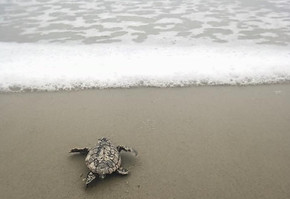Sea Turtles


Sea turtles exist throughout the world’s oceans, extending from tropical to temperate latitudes. Each of the seven species worldwide plays a distinct role in the ecosystem due to differences in dietary preferences and behaviors. Although sea turtles are aquatic reptiles, they come ashore to nest on beaches in the tropics and subtropics. During this time, nesting female sea turtles, incubating eggs, and hatchlings emerging from the nest are vulnerable to a number of natural and anthropogenic threats. These can include – but are not limited to – habitat loss to beachfront development, coastal light pollution, rising sea levels due to climate change, and uninformed beachgoers exhibiting behaviors that are not sea turtle-friendly.
Our lab works with multiple species of sea turtles both within the United States and internationally in Costa Rica. Specifically, our work in the U.S. has focused on the most dominant nesting species in the Southeast, the loggerhead sea turtle (Caretta caretta). We have studied the factors influencing sea turtle nest success, beach habitat management, and ways to reduce anthropogenic impacts to sea turtles through education programs.
Our international research incorporates the same goals as our domestic research, but with different study species. The locations at which we work along the Pacific Coast of Costa Rica are nesting sites for the olive ridley sea turtle (Lepidochelys olivacea) and the critically endangered hawksbill sea turtle (Eretmochelys imbricata). Apart from these primary study species for our lab, green (Chelonia mydas) and leatherback (Dermochelys coriacea) sea turtles also nest at our field site beaches. Additional aims of our Costa Rica research include basic population monitoring, nest protection efforts from poaching, and habitat health and restoration. Some of this research extends beyond the nesting beach and into the nearshore and coral reef habitats used by sea turtles.







.png)